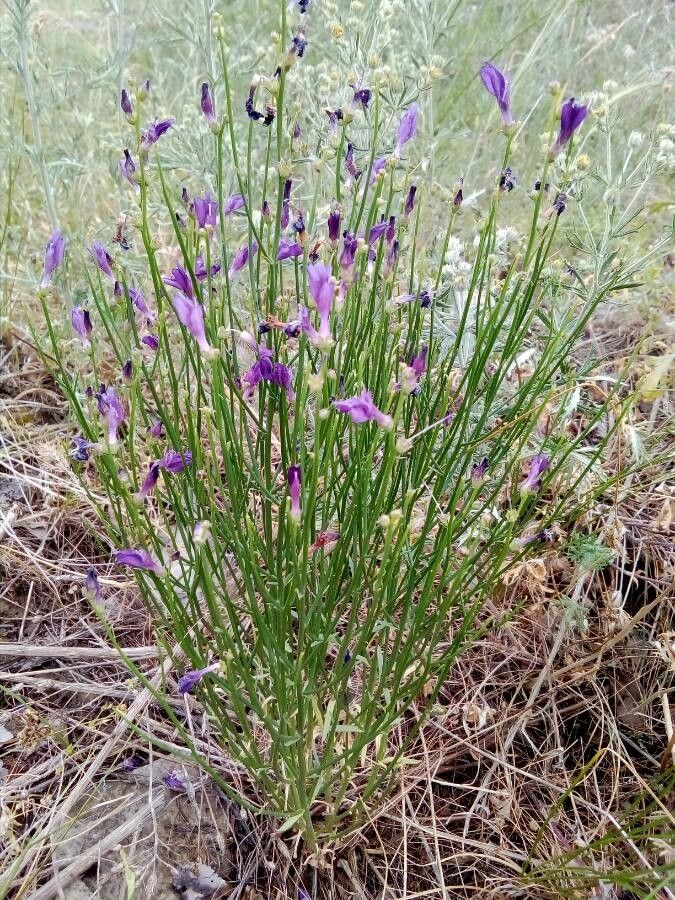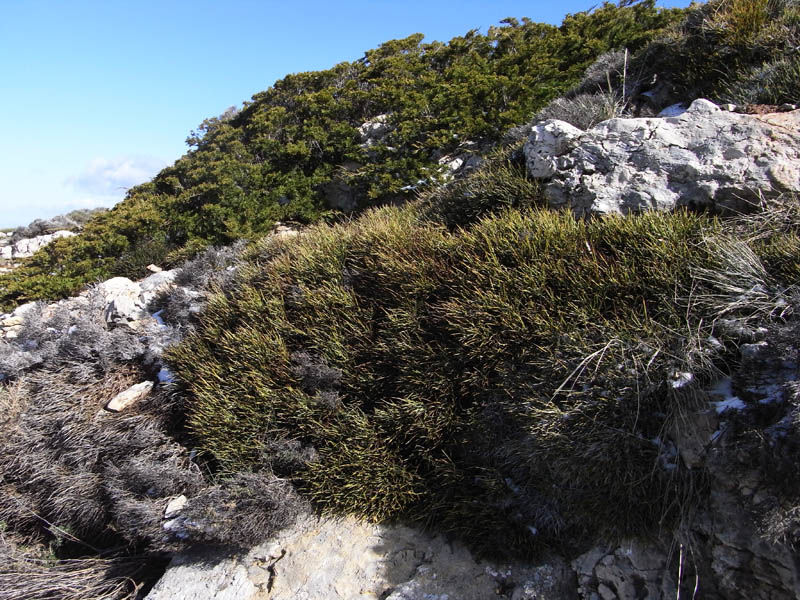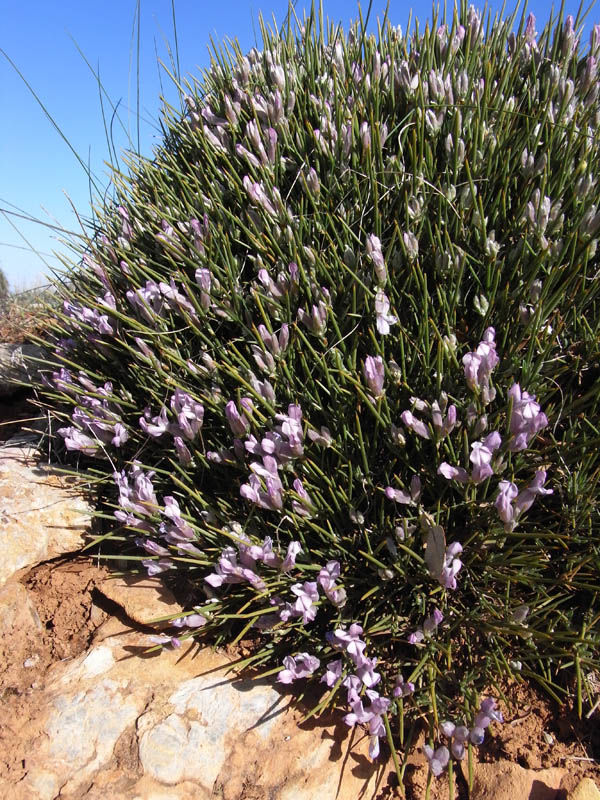Hedgehog broom
erinacea anthyllis
Also known as: ["Hedgehog broom","Erinacea anthyllis"]
Overview
A deciduous shrub native to the Mediterranean region, characterized by spiny stems and yellow flowers.
Benefits & Perks
["drought tolerant","wildlife attractant (bees, butterflies, birds)"]
Botanical Classification
| Phylum: | Magnoliophyta |
| Class: | Magnoliopsida |
| Order: | Fabales |
| Family: | Fabaceae |
| Genus: | Erinacea |
| Botanical Name: | Erinacea anthyllis |
Plant Characteristics
Basic Information
- Category: Shrubs
- Suitable Location: rock garden, alpine trough, or sunny border
- Suitable For:
- Is Weed: No
- Allergenicity: low
Environmental Needs
- Climate: {"temperatureRange":"–10–35°C"}
- Hardiness: {"zones":"5–8"}
- Misting: rarely required, only if ambient humidity is very low
- Drainage: Fast-draining to prevent waterlogging.
- Soil Type: Well-draining, sandy loam with some organic matter.
Maintenance Level
- Maintenance Level: moderate
- Toughness Level: high
- Pruning Frequency: Annually in late winter or early spring before new growth begins.
- Pruning Intensity: Moderate pruning to shape the plant and remove up to one-third of old growth.
Care Details
Ideal Sunlight Coverage:
Full sun (6–8 hours/day) with some afternoon shade in hot climates. Adjust for seasonal light intensity.
Sunlight Tolerance Tips:
Acclimate plants gradually to intense sunlight. Protect from harsh afternoon sun to prevent scorching. Indoors, place near a south-facing window with filtered light.
Care Requirements
Care Difficulty
moderatemoderate
Sunlight
full sun to partial shade
Rotate plant for even light exposure; use sheer curtains to filter intense sun; monitor for signs of sunburn.
Watering
every 7–10 days during active growth, reduce in winter
Water thoroughly until runoff, ensure soil dries between waterings, and avoid overhead watering to prevent fungal issues.
Soil
well-drained, rocky or sandy soil
pH: Slightly acidic to neutral (pH 6.0–7.0).
Use raised beds for better drainage; avoid heavy clay soils; amend with organic matter for fertility.
Temperature
Prefers temperate conditions, 60–75°F (15–24°C). Tolerates mild frosts but avoid prolonged freezing.
Avoid sudden temperature fluctuations; protect from drafts; maintain consistent indoor temperatures.
Fertilizing
every 2–3 months during spring and summer
Fertilize lightly in spring; avoid over-fertilizing; flush soil occasionally to prevent salt buildup.
Propagation
Methods
Stem cuttings or division. Stem cuttings are more common for home growers.
Step-by-Step Propagation Guide
- Take cuttings.
- Apply rooting hormone.
- Plant in medium.
- Maintain humidity.
- Transplant once rooted.
Best Time: Late spring to early summer when the plant is actively growing.
Environment
Warm, humid environment with indirect light and consistent moisture.
Medium
Well-draining mix of perlite and peat moss or cactus mix.
Hormone
Rooting hormone is recommended to improve success rates.
Timeline
Roots may develop in 4–8 weeks; establishment takes 3–6 months.
Tools Needed
Pruning shears, rooting hormone, pots, well-draining medium, plastic wrap or propagator.
Quick Tips
Use healthy, non-flowering stems; maintain high humidity; avoid direct sunlight during rooting.
Pruning & Repotting
Pruning Guide
Method
Use clean, sharp tools; make cuts just above a leaf node or branch junction; remove crossing or crowded branches.
Pruning Plan
Prune to maintain shape, encourage bushiness, and remove dead or diseased growth.
Tools
Pruning shears, sterilizing solution, gloves.
Checklist
Sterilize tools; prune dead/diseased wood; shape the plant; clean up debris.
Repotting Guide
Best Season
Early spring before active growth starts.
Pot Size
Increase pot size by 2–3 inches in diameter.
Method
Remove plant gently; trim roots if needed; place in a new pot with fresh, well-draining soil; water lightly.
Suggestions
Repot every 2–3 years or when roots fill the container. Necessary to refresh soil and provide space.
Checklist
Choose appropriate pot; prepare new soil; inspect roots; water after repotting; place in appropriate light.
Advanced Care Tips
Watering Mastery
Watering Checklist
Check soil moisture before watering; water deeply; ensure drainage; avoid wetting foliage.
How to Apply Water Properly
Water at the base of the plant, ensuring moisture reaches the root zone. Water early in the day to minimize evaporation and allow foliage to dry.
Watering Schedule Tips
Water deeply but infrequently, allowing soil to dry between waterings. Reduce frequency in winter to prevent root rot.
Soil Improvement
Add perlite or coarse sand for drainage; incorporate compost for fertility; ensure good aeration.
Temperature Stress Management
Signs of Temperature Issues
Chlorosis, leaf drop, stunted growth, or wilting in extreme heat or cold.
Cold Stress
Slows growth, may cause leaf discoloration, and increases susceptibility to root rot if soil remains wet.
Solution: Provide winter protection with mulch; ensure good drainage; move potted plants to a sheltered location.
Hot Stress
Leaves may wilt, scorch, or drop. Growth may slow, and flowering can be reduced.
Solution: Provide shade during peak heat; increase watering frequency; use mulch to retain soil moisture.
Fertilizing Guide
Fertilizing Checklist
Use balanced fertilizer; apply in spring; avoid winter feeding; monitor for nutrient burn.
Fertilizing Method
Use a balanced, slow-release fertilizer in spring. Dilute liquid fertilizer to half-strength if needed. Avoid fertilizing in winter.
Common Problems & Solutions
Toxicity Warning
Cats
Non-toxicErinacea anthyllis is not known to be toxic to cats. It does not pose a significant risk if ingested or handled.
⚡ Toxic If:
None
Dogs
Non-toxicErinacea anthyllis is not known to be toxic to dogs. It does not pose a significant risk if ingested or handled.
⚡ Toxic If:
None
Humans
Non-toxicErinacea anthyllis is not known to exhibit toxic properties to humans. It is generally considered safe for handling and consumption.
⚡ Toxic If:
None
Frequently Asked Questions
Q: Is Erinacea anthyllis toxic to pets?
A: There is no reliable information available regarding its toxicity to pets.
Q: How often should I water Erinacea anthyllis?
A: Water sparingly, as it is drought tolerant and prefers well-drained soil.
Q: Does Erinacea anthyllis attract wildlife?
A: Yes, it attracts bees, butterflies, and birds due to its nectar-rich flowers.
Quick Reference
| Family: | Fabaceae |
| Care: | moderate |
| Light: | full sun to partial shade |
| Water: | every 7–10 days during activ |
Get Expert Care Tips
Download the Plantious app for personalized care reminders and plant identification!
Google Play App Store








